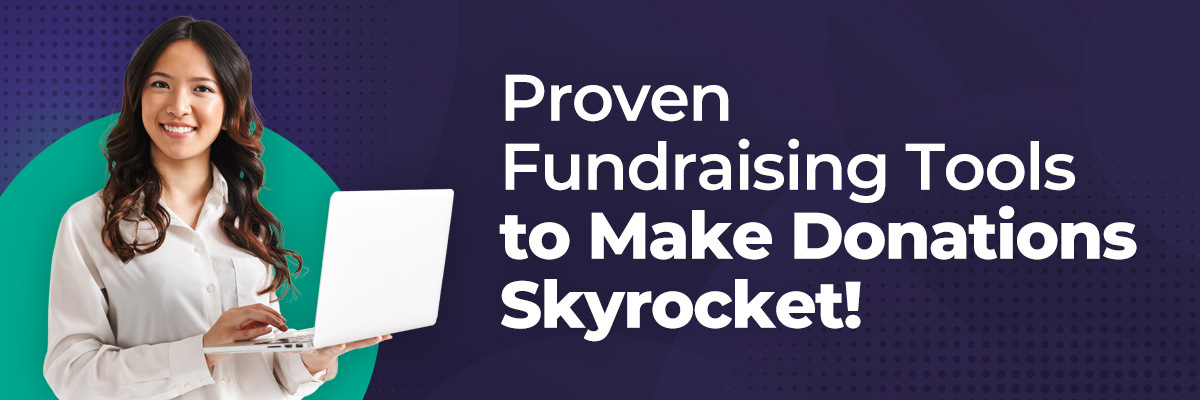
Nonprofit organizations must use every platform available to them to maximize fundraising. Online platforms are among the most effective. They can save costs, improve return on investment (ROI) and help you reach more people.
Table of Contents
- Importance of Digital Fundraising for Nonprofits
- Understanding Your Audience
- Building a Strong Online Presence
- Crafting Compelling Narratives
- Implementing Email Marketing Campaigns
- Using Peer-to-Peer Fundraising
- Integrating Donation Tools and Platforms
- Measuring and Analyzing Your Efforts
- FAQs
- 100+ Free Tools for Nonprofits to Inspire Unprecedented Generosity
Importance of Digital Fundraising for Nonprofits

These days, everyone is on the internet, so you can’t afford to miss out on engaging with donors through digital platforms. Online marketing will impact donations in a major way.
Additionally, online fundraising saves on costs. For example, you can create a social media post for free. Although there are several premium digital marketing services, their costs are typically lower than traditional marketing.
Virtual fundraising also provides insightful analytics so you can determine the best methods for reaching your donor base and increasing conversions.
A MatchPro 360 report shows that 31% of all donations consist of nonprofit online giving. It also shows that 63% of donors prefer to give online. If you’re not connecting with donors virtually, you could disappoint them and miss out on a huge percentage of your virtual giving for nonprofits.
Understanding Your Audience

Many nonprofits understand the value of digital fundraising, but they are unsure how to connect with their audiences. The first step involves identifying your audience. Know their likes and dislikes so you can create a targeted marketing approach.
Identifying Target Demographics
Begin by building donor personas based on demographics. Traditional demographics include age, location, profession, marital status, ethnicity and home ownership.
You can apply additional demographics like where the donor is in the funnel, donation amounts and donation frequency.
Become familiar with your existing customer’s demographics to determine who to target.
Analyzing Donor Behavior and Preferences
Once you establish your donor personas, learn about their behaviors and preferences. What social media channels do they use and when are they most active? What payment methods do they prefer? This research will help you determine the best ways to reach your audience and the ideal collection platforms.
You should also learn about their likes and dislikes. Do they use trending expressions? Are they passionate about specific causes? Answer these questions to make your marketing materials more relatable.
Building a Strong Online Presence
A strong online presence will get your organization noticed and send a cohesive message throughout your campaign. Here are some factors to consider.
Create a User-Friendly Website with a Clear Donation Page
A website is the first impression donors get when interacting with your company. A user-friendly format boosts engagement and minimizes bounce rates.
Make it easy for donors to learn what your organization is about. Avoid cluttered pages. Place navigation buttons at the top where they are easy to find.
The most important aspect of a user-friendly nonprofit site is the donation page. Include Donate’ buttons in strategic locations throughout your website to make them easy to find and click on. Make the checkout process easy by limiting fillable fields and accepting various payment methods.
Use Social Media for Outreach and Engagement
Social media is an effective way to connect with donors. Empower Agency statistics reveal that 55% of people who engage with nonprofits on social media take some sort of action: 59% donate money, 53% volunteer and 52% donate food, clothing and other personal items.
There are various platforms to choose from and many ways to connect with donors. You can build followings and publish posts to boost engagement. Advertise events through posts and event pages. You can also create paid ads to reach new donors in your target audience.
Use Consistent Branding Across Platforms
You may use various platforms, but it’s essential to keep your branding consistent in all your touchpoints. Once you create an identifiable brand, people will recognize your organization and know what it’s about. You will build solid donor relationships and connect people to your cause.
Take Coca-Cola, for instance. Everyone knows the Coca-Cola logo. For many, it has become an integral part of their lives and memories. When people see the logo, they know what to expect.
You can produce a similar effect by using colors, fonts, and a voice that expresses your brand image. Create a logo and a mission statement that connects your online presence to your organization. Make your organization a part of your community’s fabric.
Crafting Compelling Narratives
Storytelling plays an integral role in marketing. It helps you tell people what your company is about and build deeper relationships with your donors. Here’s why you should make it an integral part of your marketing mission.
Importance of Storytelling in Fundraising
Storytelling is a powerful way to build relationships with your donor base. To better understand its impact, let’s use a plumbing company as an example. Most plumbing companies provide similar services, making price a main differentiator.
Now say one of these companies puts a story on their website explaining that they grew up with limited resources. They were forced to learn plumbing to clear their family’s drainage system. You instantly set your company apart from the competition and forge an emotional connection with your brand.
Nonprofits are lucky because they have so many stories to tell. They can talk about their causes and why they became connected to them. They can discuss specific challenges they are facing.
For example, an animal shelter may tell the story of a pet that needs their help. Organizations can also share success stories or let viewers know about what happened at various fundraising events.
Use Testimonials and Case Studies to Build Trust
Testimonials and case studies are stories in and of themselves, and they help you build trust with donors. They are the best kind of social proof. These assets demonstrate how you have helped your community and establish your reputation in the fundraising space.
Nonprofits can post testimonials from people and organizations they’ve helped and individuals who have volunteered with their organizations. Testimonials can be written text, but they may be more engaging in video form. They can be shared across various platforms including websites, emails, newsletters and social media.
Blog Posts and Videos That Highlight Your Cause
Nonprofits can choose from various media to tell stories that connect them to their donor bases. Blogs and videos are among the most effective.
Blogs are ideal because they integrate search engine optimization (SEO) keywords that can improve search engine ranking. They are easy to skim for people with short attention spans. You can also reuse blog ideas to create other content types.
Videos are another popular marketing tool. People enjoy them because they provide audio and visual elements to tell the whole story. According to Sprout Social, 87% of marketers see a direct increase in conversions when using video in social media campaigns.
Implementing Email Marketing Campaigns
Email marketing stands out as one of the most effective ways to reach donors. A Neon One report reveals that the average nonprofit email campaign has a 28.59% open rate and raises $1.11 per email contact. Here’s how you can make your emails more impactful.
Craft Persuasive Emails for Different Donor Segments
Earlier in the article, we discussed the value of identifying donor personas. Once you identify those personas, segment them to send targeted emails based on demographics. For example, if you are targeting donors with low donor frequency, you can advertise a recurring subscription service. If you are targeting lapsed donors, explain why you need their help now more than ever.
Conduct A/B Tests on Subject Lines and Calls to Action
A/B testing is crucial to a successful email campaign. It helps you identify what’s working and what isn’t, so you can make necessary improvements.
The process typically involves changing just one element of your email so you can identify what led to a change in open rates, click-throughs and other key performance indicators (KPIs). The subject line and calls to action (CTAs) are effective places to start.
- Your subject lines play the biggest role in getting people to engage with your emails. Experiment with different emotions and action words to increase engagement.
- CTAs are typically included at the end of the email, asking or instructing recipients to take desired actions. You can ask them to donate, explore your website to learn more about your cause or sign up for your newsletter. Use A/B testing to determine which gets the best response.
The Importance of Follow-Up Emails and Acknowledgements
According to a recent HubSpot study, the open rate for marketing emails is only 2.4%. You must continue to send emails to increase your chances of a conversion. One email is not enough. Keep following up until you get a response.
But emails are not just about marketing. They can be used to thank people for donations, send updates about your cause and let donors know how their donations have helped your organization reach its goals.
Using Peer-to-Peer Fundraising
Peer-to-peer (P2P) fundraising involves asking individuals to raise funds on behalf of your organization. You may recruit volunteers to ask their friends and family to donate. They may also organize fundraising events that support your cause.
P2P fundraising is beneficial because it reduces the time and effort organizations put into fundraising.
You can set up P2P fundraising by following four steps.
How to Set Up P2P Campaigns
- Find a fundraising platform. The platform will enable you and your supporters to create individual donation pages that support your cause.
- Identify your goals. Set monetary goals that your supporters can work toward.
- Recruit volunteers. Identify individuals who may be willing to help, including existing donors, people you have helped in the past or new donors in your target audience.
- Market your campaigns. You can market your campaigns through storytelling, social media, gamification, influencers and other media that help you get the word out.
Encourage Supporters to Share Their Fundraising Pages
P2P fundraising pages are optimized for nonprofit online giving. Each supporter creates a unique page they can share with others to gain support. However, if they don’t share these pages, they won’t do much good.
There are several ways to encourage them to share:
- Give them a reason to share. Explain why you need their support so they understand the importance of sharing.
- Make it easy to share. Provide default messages people can add to social media posts so they don’t need to worry about getting creative.
- Support fundraisers. Show your support by sharing their fundraising pages on your platform and providing posting tips.
- Acknowledge their efforts. If a supporter posts their page, acknowledge it with a like or comment to show your appreciation. Doing so may encourage them to continue posting.
Spotlight Top Fundraisers to Motivate Others
Encourage others to support your cause by making fundraising a competition. Use a central platform to make your supporters aware of everyone’s fundraising accomplishments to inspire everyone to maximize their donations. You can also offer gifts to the supporters who generate the most virtual giving for nonprofits.
Integrating Donation Tools and Platforms
You can use various tools and platforms to promote nonprofit online giving. Here are some recommended platforms to consider that offer ease of use and manageable fee structures:
- Bloomerang: This platform stands out for its user-friendly, intuitive system. Organizations pay $125 monthly for access and a 2.2% plus 30 cent transaction fee.
- Qgiv: Qgiv is easy to use, with drag-and-drop features and free support and training. It is free to use but charges 3.95% plus 30 cents for each transaction.
- Fundraise Up: This platform offers a straightforward portal and highly responsive customer service. It charges a 4% transaction fee.
- Classy: Classy offers an intuitive design, drag-and-drop features and easy navigation. It charges a transaction fee of 2.4% plus 30 cents for credit cards and 2.5% plus 30 cents for payment apps.
- RaiseDonors: RaiseDonors offers an easy-to-use self-service portal that makes it simple to get started. It charges a 1.5% platform fee. Contact the service for custom pricing.
In addition to cost and ease of use and other features when choosing a payment processing platform, secure payment processing may be the most important. Donors will feel better knowing their payments are processed securely. It will build trust and credibility for your organization.
Measuring and Analyzing Your Efforts
Nonprofits must analyze their efforts to ensure they are successful. You can use various tools and metrics to measure a campaign’s success rate.
KPIs for Tracking Donations
Consider various KPIs when measuring success rates, including:
- Donation amounts
- Donor retention rates
- Donation frequency
- Donor growth rates
- Conversion rates
- ROI on marketing
Tools for Monitoring Campaign Effectiveness
Your customer relationship management (CRM) tool will give you an idea of your campaign effectiveness. Additionally, several marketing platforms you might use provide analytics.
For example, social media platforms indicate which posts get the most engagement and when followers are most engaged. Paid ads provide even more in-depth analytics regarding click-through rates and impressions. You can get similar metrics off email and pay-per-click (PPC) platforms.
Adjust Your Strategies Based on Data Insights
Once you get the insights you need, you can make the necessary adjustments. For example, if a post or ad performs well, you can integrate similar online giving strategies into future ads. Avoid strategies that didn’t get as much engagement.
You can also determine when your audience is most engaged and time your communication accordingly.
Continue reviewing KPIs regularly. Your data may change to align with industry trends. Evolve to ensure your strategy is optimized for updated algorithms.
FAQs
What are the best online platforms for accepting donations?
Several online giving platforms accept donations. One popular platform preferred by 40,000 organizations is Vanco, which offers online giving pages and tools to help nonprofits expand their missions.
What role does a website’s design play in maximizing online donations for nonprofits?
Website design plays a major role in maximizing online donations. A well-designed website will make it easy for donors to learn about your cause and become engaged. It also offers easy navigation to a donate button so they can support your organization. You should also consider mobile giving for nonprofits and ensure your design formats well on mobile devices.
How can I engage and communicate with donors to encourage contributions?
Keep donors engaged by communicating with them through social media, emails and newsletters. Update them on your progress and current fundraising goals. Let them know why you need their support.
How do I maintain donor engagement beyond the initial donation?
An initial donation allows you to collect contact information. You can use this information to stay in touch with donors through emails and social media. Keep them updated on activities and let them know what you are working toward to encourage repeat donations.
How can I encourage one-time donors to become recurring donors?
Ongoing contact can turn one-time donors into recurring donors. Use emails, direct messages, newsletters and social media to let them know why you still need their help. You can also run campaigns designed to convert one-time donors. Offer swag and other gift items to people who sign up for your recurring donation system.
100+ Free Tools for Nonprofits to Inspire Unprecedented Generosity!
We’ve put together 100+ pro tools and templates that are guaranteed to boost your nonprofit’s fundraising—no guesswork, no fluff. Here’s what’s inside:
- Word-for-word fundraising scripts that turn "no" into "yes"
- Fundraising letter, email and thank you templates for every situation.
- Event planning and evaluation tools including checklists, reports, evaluations, surveys and more
- Plug-and-play sponsorship proposals and templates sponsors can't resist
- Free design materials that make your events look professional
- Donation Receipt Templates for every type of contribution
- 7 AI bots to handle repetitive tasks and save you hours
The only question left: Are you ready to turn the chaos into success?
Act now!
5 Minutes to Fundraiser Success: The No-Hassle, Risk-Free Event Management Option for Nonprofits

Imagine setting up your next fundraising event in just five minutes. That’s what Vanco does for you—no learning curve, just a quick setup and an easy, intuitive system. You can try it risk-free and discover what thousands of nonprofits already know: event management doesn’t have to be a chore.











